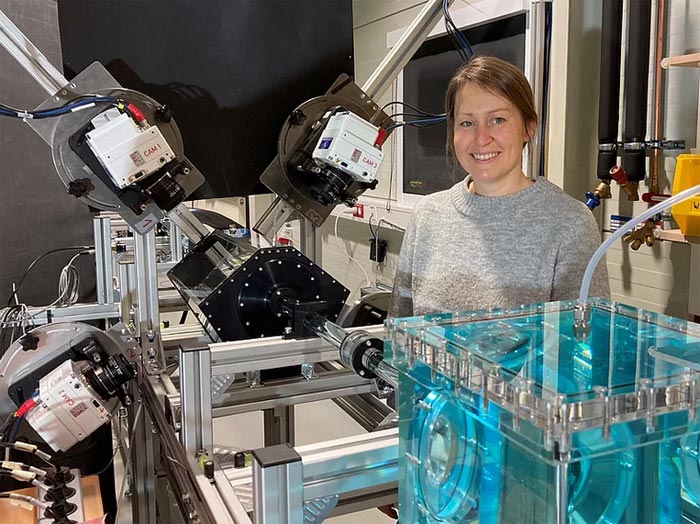When Fuel Sloshes Dangerously

With the help of four high-speed cameras, Dr. Kerstin Avila gets to the bottom of the movement of particles in a pipe flow.
© Kerstin Avila / Universität Bremen
New Research Findings…
Coffee sloshing over the rim of a cup: annoying, but bearable. Sloshing fuel in rockets or tankers: more dangerous. Dr. Kerstin Avila from the University of Bremen conducts research on this topic and on turbulence – with success, as two outstanding publications now show.
Sloshing coffee is known to many people as an annoying everyday problem that one can and must live with. In engineering, however, such dynamics can have fatal effects. “Sloshing fuel endangers the flight stability of rockets, for example. Or the transport of liquefied gas in tankers becomes dangerous if the sloshing aligns with the ship’s motion,” says Dr. Kerstin Avila, a process engineer within the Faculty of Production Engineering at the University of Bremen and at the Leibniz Institute for Material Engineering (IWT). Together with other European researchers, she has presented completely new research results that have now been published in the renowned journals Nature Communications and Physical Review Letters.
Resonance of Sloshing Wave Motion Reliably Predicted
Predictions regarding the resonance of sloshing fluids with other motions were previously only possible to a limited extent. In cooperation with theorists at ETH Zurich, Kerstin Avila and her experimental fluid mechanics team have now succeeded in reliably predicting resonances of sloshing wave motions for the first time. To do this, they broke completely new ground in research by combining abstract theories, machine learning, and experiments. “We have shown that all the information needed for the prediction is contained in very few measurements that our team took,” says Kerstin Avila.
Together with three researchers from Austria, Poland, and France, Kerstin Avila showed in another study that the distribution of turbulence is subject to very simple laws. “These laws do not apply specifically to fluids, but also describe in a first approximation, for example, the spread of a virus through the population or a forest fire,” Kerstin Avila states and mentions another interesting aspect. “At its core, the theory of ‘direct percolation’ is behind these propagation dynamics, which is a theory used in many scientific fields to explain phenomena.”
Milestone: Resilient Data Instead of just a Projection
Until now, the predicted numbers, which in the case of virus spread, for example, are ultimately based only on projected data, have never actually been observed exactly in nature, or been viewed in the frame of a spatially extended experiment. However, this is exactly what the team and the process engineer from Bremen have now succeeded in doing with a flow experiment after years of research. “This is a real milestone for the confirmation of the theory and for the description of the turbulence transition,” the scientist is pleased to say.
For her research within the projects presented here, Kerstin Avila has been supported by the central research funding of the University of Bremen for two years. As a postdoctoral researcher, this gives her the opportunity to pursue her work with an independent project in a highly productive environment, to network internationally in her respective scientific community, and to meet the requirements for appointment to a lifetime professorship. The young scientist has chosen the renowned process engineers Professor Lutz Mädler and Professor Udo Fritsching from the University of Bremen and the Leibniz Institute for Material Engineering in Bremen as “hosts” for this research.
Additionally, Kerstin Avila is investigating the movement of particles in tube flows with a pulsating mass flow as part of the interdisciplinary research unit FOR 2688 (engineering science, physics, medicine). The project, which is funded by the German Research Foundation (DFG), aims to better understand the fluid dynamic aspects of blood flow.
Links to the original publications:
M. Cenedese, J. Axås, B. Bäuerlein, K. Avila K, G. Haller G: Data-driven modeling and prediction of non-linearizable dynamics via spectral submanifolds, Nature Communication, https://www.nature.com/articles/s41467-022-28518-y
L. Klotz, G. Lemoult, K. Avila, and B. Hof: Phase Transition to Turbulence in Spatially Extended Shear flows, Physical Review Letters,
https://journals.aps.org/prl/abstract/10.1103/PhysRevLett.128.014502
Further Information:
https://www.uni-bremen.de/en/mvt/team/dr-rer-nat-kerstin-avila
www.uni-bremen.de/en/
Contact:
Dr. Kerstin Avila
Experimental Fluid Mechanics
Department of Particles and Process Engineering
Faculty of Production Engineering
University of Bremen
Phone: + 49 421 218-51241
Email: kavila@uni-bremen.de
Wissenschaftliche Ansprechpartner:
Dr. Kerstin Avila
Experimental Fluid Mechanics
Department of Particles and Process Engineering
Faculty of Production Engineering
University of Bremen
Phone: + 49 421 218-51241
Email: kavila@uni-bremen.de
Originalpublikation:
M. Cenedese, J. Axås, B. Bäuerlein, K. Avila K, G. Haller G: Data-driven modeling and prediction of non-linearizable dynamics via spectral submanifolds, Nature Communication, https://www.nature.com/articles/s41467-022-28518-y
L. Klotz, G. Lemoult, K. Avila, and B. Hof: Phase Transition to Turbulence in Spatially Extended Shear flows, Physical Review Letters,
https://journals.aps.org/prl/abstract/10.1103/PhysRevLett.128.014502
Media Contact
All latest news from the category: Machine Engineering
Machine engineering is one of Germany’s key industries. The importance of this segment has led to the creation of new university degree programs in fields such as production and logistics, process engineering, vehicle/automotive engineering, production engineering and aerospace engineering among others.
innovations-report offers informative reports and articles covering technologies such as automation, motion, power train, energy, conveyor, plastics, lightweight construction, logistics/warehousing, measurement systems, machine tools and control engineering.
Newest articles

Innovative 3D printed scaffolds offer new hope for bone healing
Researchers at the Institute for Bioengineering of Catalonia have developed novel 3D printed PLA-CaP scaffolds that promote blood vessel formation, ensuring better healing and regeneration of bone tissue. Bone is…

The surprising role of gut infection in Alzheimer’s disease
ASU- and Banner Alzheimer’s Institute-led study implicates link between a common virus and the disease, which travels from the gut to the brain and may be a target for antiviral…

Molecular gardening: New enzymes discovered for protein modification pruning
How deubiquitinases USP53 and USP54 cleave long polyubiquitin chains and how the former is linked to liver disease in children. Deubiquitinases (DUBs) are enzymes used by cells to trim protein…



